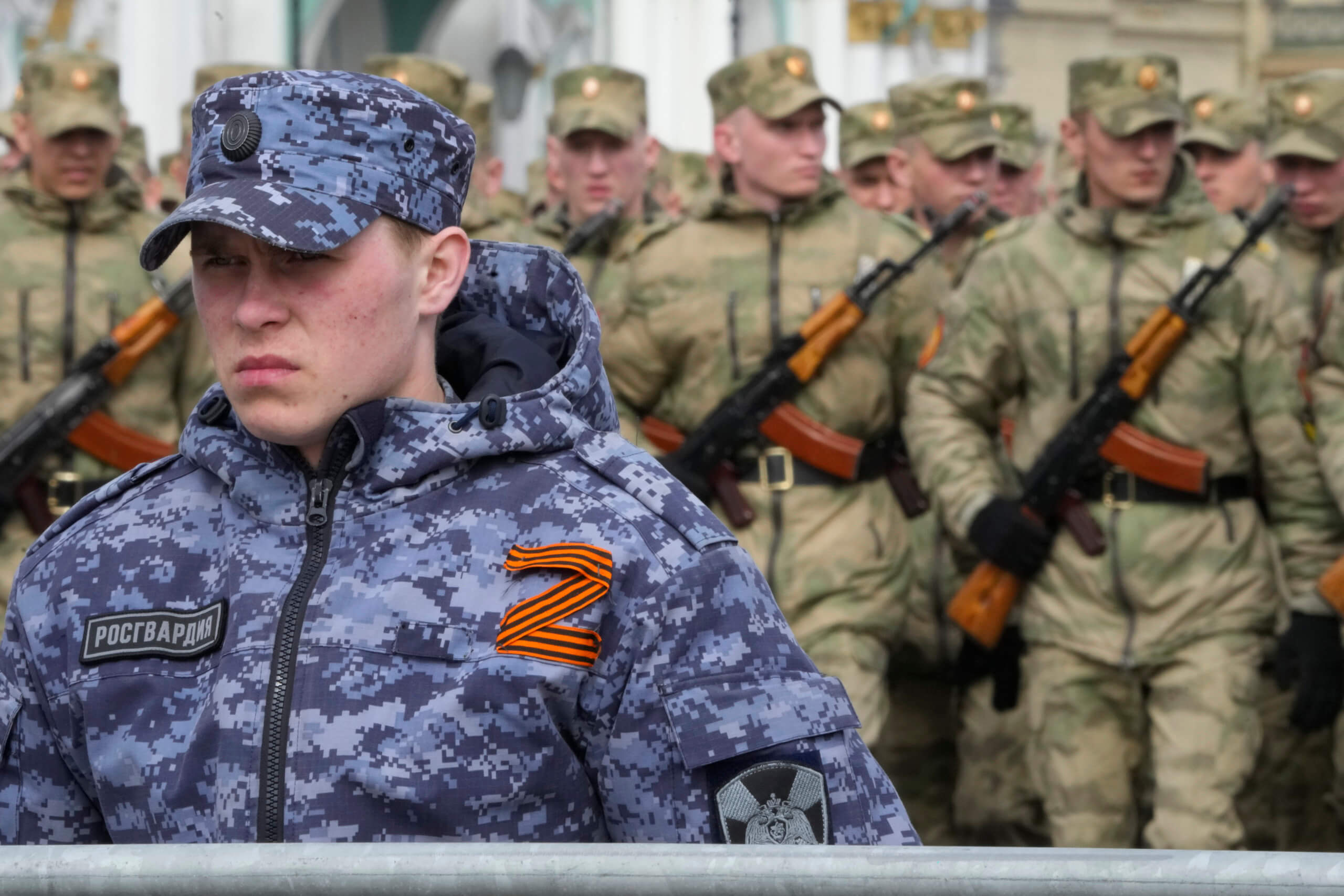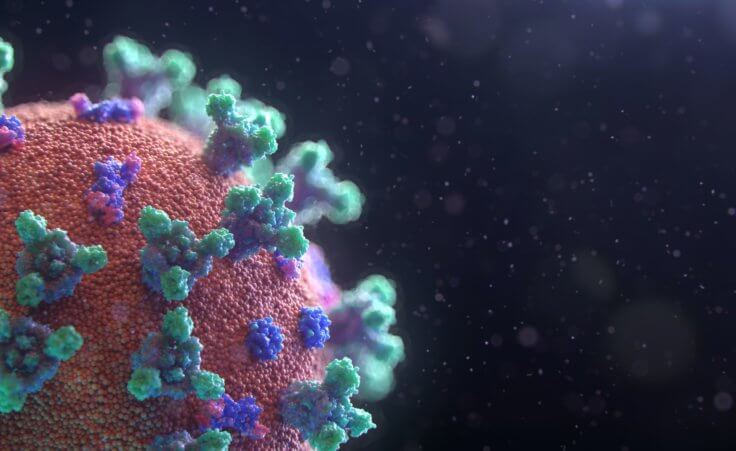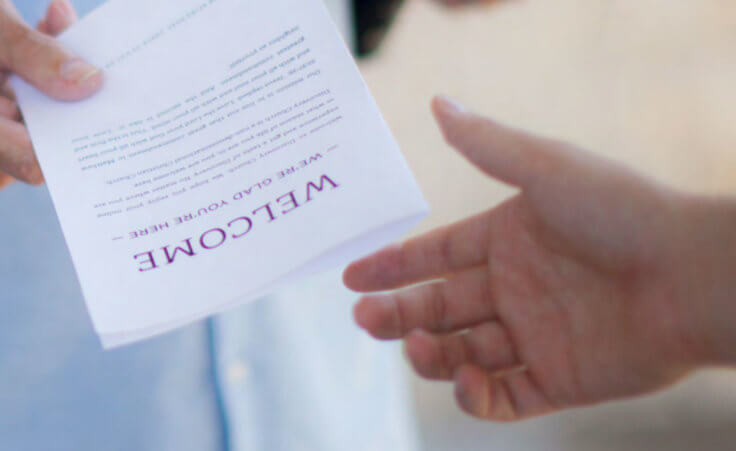
A soldier of Russian Rosguardia (National Guard) with an attached letter Z, which has become a symbol of the Russian military, stands guard during a rehearsal for the Victory Day military parade which will take place at Dvortsovaya (Palace) Square on May 9 to celebrate 77 years after the victory in World War II in St. Petersburg, Russia, Tuesday, April 26, 2022. (AP Photo/Dmitri Lovetsky)
When Russia began its invasion of Ukraine in late February, commentators immediately noticed something strange in video footage of the invading force. Markings and symbols painted in white appeared on Russian military vehicles of all kinds. There were circles, Xs, As, Vs, and Zs.
Intrigue built up around the characters since there is no letter “Z” in the Russian alphabet (the equivalent character looks like a 3). Now, it’s pretty well accepted that these symbols were an easy way to mark Russian vehicles for tactical purposes and helped them avoid friendly fire. Each symbol might denote the vehicle’s direction of attack. For example, Z may have stood for Zapad (west).
But in March, a Russian gymnast taped a Z to his uniform as he stood on a podium next to a Ukrainian gymnast. At that point, it was clear that it meant much more beyond its use as a tactical symbol and has since grown to become a sign of support for the war in Ukraine throughout the country.
Where did the Z come from?
In Russian, the word for sounds like za but looks a bit like 3A. As part of this new shorthand, they are replacing 3 with the letter Z in propaganda. They use it in short, pro-war phrases like “For the president” or “For victory.” They’ve done the same thing with V.
As shorthand for support of Putin and the war easily made using one’s fingers, the Z symbol has caught on like wildfire. Some messages on social media translate to “we finish wars,” “to victory,” and “we are responsible for the world/peace.” Hashtags like #RussianLivesMatter have hundreds of millions of views on TikTok and Instagram.
Many Russian civilians use the symbol to show their support for Russia’s war cause. There is now an infamous picture of what appear to be child cancer patients on hospice forming a Z in the snow as part of a social media stunt. The Z is on billboards in Moscow, used by flash mobs of people forming the Z, and incorporated into Putin’s rallies. It was even represented in a ballerina routine. And, of course, the military has incorporated the symbol in its parades and on the battlefield.
Russia is obsessed with this pro-war symbolism.
Putin and social media
While their disinformation was somewhat effective on social media for a while, Russia actually banned Facebook and Instagram in March, calling the groups “extremist” for allowing anti-war messaging that shows support for Ukraine. Free access to information on social media is not something the authoritarian president probably wants for his people. The Kremlin also made any “fake” information on the military operations in Ukraine punishable by up to fifteen years in prison.
To protect its users, TikTok is only allowing Russians to see Russian content, creating a dangerous echo chamber of Russian propaganda. However, if they allow other content, Russian TikTok users might be charged and imprisoned under the new “fake news” laws.
Those who can get outside information and want to depose Putin have rallied in anti-war protests. But since thousands of them have been imprisoned for peacefully protesting, many critics have decided to leave Russia in exile rather than live in a country fighting an unjustified invasion.
Putin’s approval rating is sky-high
It’s important to realize that Putin’s approval ratings have jumped to around 83 percent in Russia since the war. So, at some level, this messaging and his active obscuring of the truth are working. Dr. Ryan Denison argues that Putin has used war to gain public support in the past, such as in Chechnya.
This is not only according to Russian government-sanctioned surveys but from an independent pollster. In fact, only 4 percent of Russians think Putin is responsible for the war, while most believe America and NATO forced his hand. With sanctions weakening Russia’s economy, defiance of the West seems to be on the rise. Some respondents answering these questions might have been reluctant to answer truthfully if they didn’t support Putin, even to the independent pollsters. Yet Russian support for the war continues to climb even accounting for this fear.
It may be difficult to believe, but an overwhelming majority of Russians actually believe in the cause of Putin and the war in Ukraine, partially because of an ingrained nationalism and likely because of propaganda campaigns by Russia and false information about the nature of the war.
The propaganda Z is comprised of orange-and-black stripes and represents the Ribbon of St. George, a military medal/decoration in Russia. It ties back to World War II, which paints a narrative full of nationalistic pride for Russians.
The propaganda: Russia is “de-nazifying” Ukraine
Russia frequently claims that they are “de-nazifying” Ukraine and returning Ukraine to the people. Both of these claims are demonstrably false, but all lies have a grain of truth, so it’s important to address the facts.
A small cohort of supposed Neo-Nazis has fought against Russian occupation on the Eastern front and an alt-right group has vied for political power in Ukraine. Neo-Nazism (obviously evil) is a problem, but the ideology has very little influence in Ukraine. So the idea that Neo-Nazis, as terrible as they are, somehow run the government is clearly false. And, of course, Volodymyr Zelensky is Jewish.
Putin has discussed his defense against the Western erosion of Christian values (which he sees himself as a defender of). He has justified the invasion as protecting Russian ethnic minorities in Ukraine and launched this “military operation” to “demilitarize” Ukraine. I covered these reasons for Putin’s invasion and more history in “Why does Russia want Ukraine?”
Symbols of truth
The widespread acceptance of Putin’s narrative in Russia shows that we are all easily deceived, especially when we put faith in leaders and put our ultimate trust in our country—America included. Many Christians in the US have a difficult time distinguishing between Christian nationalism (in which Christians equate their faith with unique American exceptionalism) and Christian patriotism (which is biblical). Dr. Jim Denison and Dr. Mark Turman discuss this in accessible terms on an episode of The Denison Forum Podcast.
Many Christians have used short phrases and symbols for truth, as they are often effective for communicating and easy to remember. For example, early Christians probably used a doodle of a fish symbol to easily identify other Christians in a time of persecution. This is sometimes called by its Greek name, the ichthys. They did this by drawing one half of a fish in the sand. If the other person was a Christian, they would complete the fish.
Most prominently, the cross is associated with Christianity. It reminds us that Jesus died to save us (1 Peter 2:24). As modern Christians, we should be careful not to commercialize crosses into oblivion and meaninglessness. Crosses were not decorations but first-century torture and execution devices that the Romans used to kill criminals, oppress nations, and keep millions in fear.
While short phrases and symbols are often useful, let’s make sure we don’t forget to understand their deeper, true meaning. The cross reminds us of the true death and resurrection of Jesus, the foundation of our faith.
The Z symbol serves a powerful purpose in Putin’s Russia: one of evil and deceit. When we as Christians use symbols, let’s use them toward the purposes of truth and love. If they become nothing but meaningless decorations, then they lose the power to move people toward truth.













